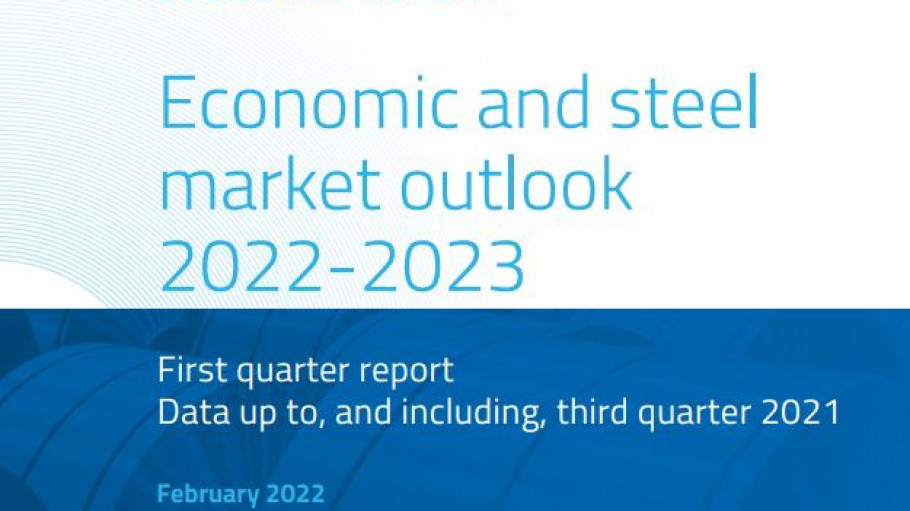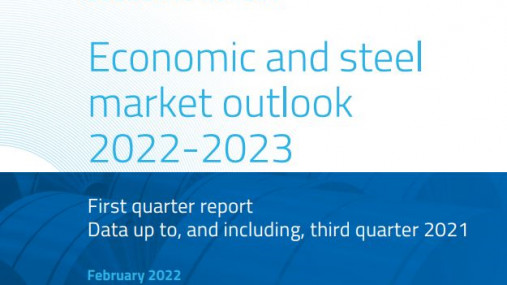
Publications » Economic and market outlook » Economic and steel market outlook 2022-2023, first quarter
Economic and steel market outlook 2022-2023, first quarter
Downloads and links
Recent updates

The positive trend in apparent steel consumption as well as in steel demand seen over the second quarter of 2021 took up also in the third quarter, albeit at a considerably slower pace, and is projected to continue in 2022. Ongoing global issues have cast uncertainty on the economic and industrial outlook, and most probably will continue to do so until the first half of 2022. In general, recovery in the EU appears to be increasingly uneven and exposed to downside risks, mainly the severe disruptions in the global supply chain (i.e., shortage of components and raw materials, skyrocketing energy prices, rising shipping costs, etc.), as well as potential new COVID-19 variants.
Recovery in steel-using industries and in steel demand is therefore expected to continue, but at a moderate rate and subject to considerable uncertainty at least until the second quarter of 2022. This is conditional upon no additional external shocks materialising, and upon a significant ease of the current pressures on global supply chains.
EU steel market overview
In the third quarter of 2021 EU apparent steel consumption increased for the fourth consecutive time in a row (+14.3%), however at a much lower rate than the exceptional one (+40.9%) recorded in the second quarter. The latter is best explained against the backdrop of extremely low consumption levels seen one year before, due to the severe disruptions caused by the COVID-19 pandemic that had marked the trough of the cycle. Albeit easing, the positive trend seen since the fourth quarter of 2020 continued also in the third quarter of 2021. Apparent steel consumption amounted to 36 million tonnes, compared to 40 million tonnes in the second quarter.
The whole of 2020 was considerably impacted by the pandemic and saw apparent steel consumption in the EU plummet (-10.7%) for the second consecutive year after a -5.1% drop in 2019. It is set to rebound (+13.8%, revised upwards from +13% in our previous Outlook) in 2021 and to grow much more moderately in 2022 and 2023 (+3.2% and +1.7% respectively), thanks to mild but continued improvement in demand from steel-using sectors. Nonetheless, the outlook is becoming increasingly uncertain due in particular to wide disruptions in the global supply chain and increasing energy prices, which are set to seriously impact demand from steel-using sectors at least until the second quarter of 2022.
Mirroring the continued improvement in demand, positive developments were also observed for domestic deliveries in the third quarter, albeit at a much lower rate (+6.6%) than the exceptional growth in volumes over the second quarter of 2021 (+40%). Over the entire 2020, deliveries fell (-9.6%) compared to 2019, marking the second consecutive decline year-on-year after 2019 (-4.2%).
Imports – including semi-finished products – into the EU continued their dramatic surge also in the third quarter of 2021 by recording +47.7% after +45% in the second quarter, as a result of stronger improvement in demand. Although these high figures partially reflect the comparison with the exceptionally low figures of the year before, nevertheless import penetration over the last two quarters has remained considerably high.
In 2020 imports from third countries fell (-17.1%) for the second consecutive year (-10.9% in 2019), reflecting the continued deterioration in steel demand and the huge impact of COVID-19 on the industry.
EU steel-using sectors
After the record lows of 2020 due to lockdown measures, steel-using industries in the EU experienced a strong rebound in output until the second quarter of 2021, when they recorded an exceptionally high rate (+29.2%). A faster-than-expected recovery in some sectors (domestic appliances and automotive in particular) has allowed to recover the losses experienced due to the pandemic over the first half of 2021.
However, major issues along the global supply chain experienced since July 2021, and especially those affecting the automotive sector (rising transportation, energy and shipping costs, shortage of components, etc.), have impacted output over the third quarter. As a result, total steel-using sectors’ output increased by a meagre +3.2%. Automotive, in particular, plunged by -14.4%, reflecting continued disruption along the supply chain as well as subdued demand from consumers.
This situation jeopardises the recovery and casts wide uncertainty on the overall steel-using industries’ outlook, at least until the second quarter of 2022.

Download this publication or visit associated links
Brussels, 22 October - Ahead of the European Council meeting on 23 October, Europe’s steel and automotive industries — two strategic pillars of the EU economy — are issuing a joint call for a realistic and pragmatic pathway to transformation and keeping investments in Europe. Together, these sectors form the backbone of Europe’s industrial strength, supporting over 13 million jobs in automotive and 2.5 million in steel (directly and indirectly), and driving innovation across entire value chains.
Joint Statement
Strasbourg, 07 October 2025 – The new trade measure presented today by the European Commission is a long-awaited proposal to forcefully defend the European steel sector, in full respect of WTO rules, from unfair imports flooding the EU market due to massive global overcapacity. The provisions unveiled by the Commission respond to the needs of the sector and represent a real lifeline for EU steelmakers and steelworkers. The European Parliament and the Council should therefore adopt it as a matter of urgency to enable its entry into force at the beginning of 2026, says the European Steel Association (EUROFER).